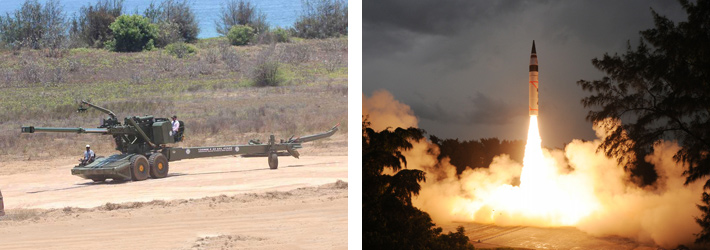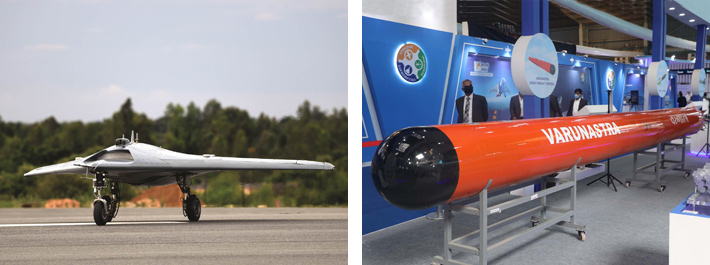INDIAN ARMED FORCES CHIEFS ON OUR RELENTLESS AND FOCUSED PUBLISHING EFFORTS

The insightful articles, inspiring narrations and analytical perspectives presented by the Editorial Team, establish an alluring connect with the reader. My compliments and best wishes to SP Guide Publications.

"Over the past 60 years, the growth of SP Guide Publications has mirrored the rising stature of Indian Navy. Its well-researched and informative magazines on Defence and Aerospace sector have served to shape an educated opinion of our military personnel, policy makers and the public alike. I wish SP's Publication team continued success, fair winds and following seas in all future endeavour!"

Since, its inception in 1964, SP Guide Publications has consistently demonstrated commitment to high-quality journalism in the aerospace and defence sectors, earning a well-deserved reputation as Asia's largest media house in this domain. I wish SP Guide Publications continued success in its pursuit of excellence.
- MoD initiates comprehensive review of Defence Acquisition Procedure 2020, pushes for defence reforms
- G7: The Swansong
- Kalinga Connect: South Asia to Polynesia
- Must Credit DRDO for Operation Sindoor, now what is next for defence R&D?
- The layered Air Defence systems that worked superbly, the key element of Operation Sindoor
- Operation Sindoor | Day 2 DGMOs Briefing
- Operation Sindoor: Resolute yet Restrained
Defending DRDO: Restructure the Responsibilities
A strategic transformation of DRDO is needed to chart a course for excellence in defence technology and a more agile and responsive future

A high-powered committee, headed by former Principal Scientific Advisor to the Government K. Vijay Raghavan Committee recommends major changes in DRDO, which is based on a renewed thrust to address the critical gaps in R&D in defence in India. Then the burden is solely put on the DRDO as the only credible institution, shouldering the entire spectrum of military technology for the Indian Armed Forces. It is also the result of a simple outcome that the most crucial aspect of building capabilities depends on many elusive technologies that are hard to acquire through existing mechanisms. What adds to the problem is the lack of R&D in the private sector in its entirety. While the reason is plenty, the core of the argument rests on the defence R&D being a heavy investment-centric exercise.
The committee’s recommendation is tabled before the highest echelons of the government and some of the reports talk about the structural changes and core competencies of the DRDO. These are speculative as usual. However, what is pertinent is the fundamentals which revolve around the anomalies which exist. It is also true that DRDO as an institution, a lone warrior, is responsible for the Research, Design & Development of military systems & platforms, the scale is so staggering, it baffles!
DRDO: Many Tasks, Myriad Roles
DRDO was established in 1958 to build up science-based capability towards making improvements in existing weapon systems including imported equipment. Later on, during the seventies, it got involved in the development of armaments and ammunition. Thrust was given to major programmes, like the development of guided missiles, electronic warfare systems, aircraft, communication systems, etc, in the 1980s. These programmes gave a new impetus to multiple design and technology centres, which resulted in the productionisation of weapon systems during the 1990s.
As these arms manufacturing countries offered only the “Buy” category of systems to India, it became mandatory for DRDO to develop each system, sub-systems, and components abinitio including infrastructure and testing facilities of their own volition indigenously.
DRDO has a mission mode structure, headed by the Secretary, Department of Defence Research & Development and Chairman, DRDO. The Secretary is assisted by the Director Generals (DGs). The Organisation has Corporate Head Quarters at New Delhi and laboratories/establishments, regional centres, field stations, etc spread all over the country from Jodhpur to Tejpur and Leh to Kochi.


These are engaged in R&D activities in the field of aeronautics, armaments, missiles, combat vehicles, advanced computing & networking, electronics, optoelectronics, military engineering systems, life sciences, advanced materials & composites, underwater sensors/weapons, warship technology, low-intensity conflict technologies, NBC Technology, cyber security etc. These laboratories and establishments have been grouped into the following 7 clusters.
These are Naval Systems & Materials (7 labs); Missiles & Strategic Systems (6 labs); Aeronautical Systems (4 labs); Armaments & Combat Engineering system (4 labs); Microelectronic Devices & Comp. Systems (5 labs); Life Sciences (8 labs); and Electronic & Communications Systems (6 labs).
With such a staggering infrastructure what ails then?
The Budgetary Constraint
Time and again, the R&D comes into focus and the accountability is measured in terms of the number of systems and platforms inducted—the applied side of the whole R&D. The question is raised over the expenditure while the irony is all about the insufficient budget in R&D itself.
Over the years, it has gone up and touched 23,263.89 crore for the Financial Year 2023-24 with a corresponding increase in several projects/programmes. Out of the total allocated budget of 23,263.89 crore, approximately 34.90 per cent is utilised for the development of strategic systems and 65.10 per cent for the tactical and other systems, including salaries, transportation, training, miscellaneous, etc. The total (Net) budget for Defence R&D is 5.38 per cent of Defence Budget (4,32,604.72 crore). 65 per cent of funds are earmarked for R&D activities, and the fund requirement for the strategic scheme is 6,140 crore, which is about 52 per cent of funds earmarked for R&D.
Some of the best projects of DRDO have been based on the Mission Mode (MM) Projects like Medium Range Surface to Air Missile (MRSAM) system for Indian Air Force, LCA Mk-II, LRSAM, Quantum Communication for Metropolitan Cities (QMAN), Airborne Early Warning & Control System Mk – II (AEW&C Mk-II) for IAF and Advanced Light Weight Torpedo (ALWT).
The Directed research is managed by Directorate of Futuristic Technology Management (DFTM) and DRDO has established eight Advanced Technology Centres (ATCs) at the premier institutes for carrying out research in the niche technology areas related to defence & security. The ATCs conduct the basic & applied research to offer solutions for technological or engineering challenges to raise the technology readiness level.
Additionally, DRDO has a strong partnership with 50 Public Sector Undertakings (PSUs), 30 Ordnance Factories (OFs) and more than 1,800 private sector industries. This has enabled the Organisation to minimise the effect of the sanctions and technology denials, which were imposed by the technologically advanced countries from time to time and also to enhance self-reliance in Defence Products.
Restructuring DRDO
As speculated, besides the committee’s binding report which is not in the public domain, the role of the private players in defence is now a fact which government has been talking about in terms of policy as well as in procurement.
The suggestion that DRDO must focus onthe core research and development is already agreed upon. What is being deliberated on whether DRDO should also be actively engaged in developing prototypes or technology demonstrators?
As we take a look a look at some of the Technology Demonstration (TD) projects, it provides some direction as, for technology demonstration, maturity is the key to selfreliance in defence. These are some of the areas where the future role of DRDO can be assessed in Active Electronically Scanned Array (AESA) Radar, New Generation Anti-Radiation Missile (NGARM), Supersonic Missile Assisted Release of Torpedo (SMART), Beam Combined Fiber Laser Source (BCFL) and Digital Fuel Flow Controller.
Global R&D giants like the Defence Advanced Research Projects Agency (DARPA) (US), EADS (Europe), DD R&D (Israel) and of course, SRSC (China) have their standards and certainly are counted among the best. Certainly, there will be evaluation and comparison. However, India must adopt the model which is the best mix. For example, according to a senior DRDO scientist, without a technology demonstrator, some very highstakes futuristic projects may be in jeopardy. While working together with private industries, there must be a collaboration. Later, the DRDO can pass the baton for the production and upgradation to private players or public sector undertakings. If we look at some of the major spending in the advanced countries, the R&D budget is marked in the range of a few billion of US Dollars for specific projects -- advanced and futuristic.
Another key recommendation is the most crucial which is all about the test facilities for various systems. DRDO must optimise its vast network of R&D infra where the private players get to use such facilities.
However, over the years, the idea that institution of such a national importance be placed under the Prime Minister’s portfolio has received greater acceptance. It is the usual comparison with the success story of the ISRO as various programmes are seen as a great success, it is also about the greater accountability which matters.
Additionally, some structural changes are on the horizon like the rationalising the post of Secretary (Research and Development) in the MoD as the DRDO Chairman currently holds dual responsibility which also takes a good deal of administrative works amid the piles of files.
The author is a defence editor and security expert. He writes on National Security, Military Technology, Strategic Affairs & Policies.





